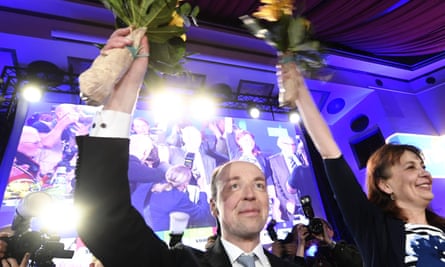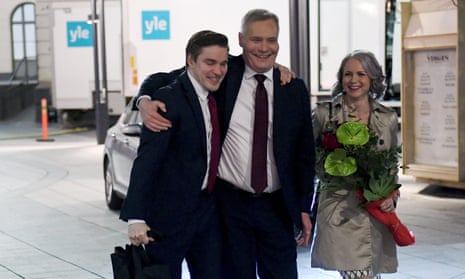Finland is heading towards a broad but potentially fragile left-right coalition government after the Social Democrats came top for the first time in 20 years.
The centre-left SDP looks set to keep out the nationalist Finns party, which it beat by just 6,800 votes, and is likely instead to try to form a government with parties of the left and centre-right.
The SDP, led by Antti Rinne, a 56-year-old former trade union leader, will have 40 MPs in a fragmented 200-seat Eduskunta (parliament) after winning 17.7% of the vote after a fierce anti-austerity campaign.
Nevertheless, the far-right, anti-immigration and increasingly radical Finns party did better than expected, winning 17.5% and 39 seats – almost exactly the same as its total in elections in 2011 and 2015, but significantly more than it might have hoped for earlier this year.
On a good night generally for the left, the SDP finished with six more MPs than in the previous parliament, while the Greens gained five and the more radical Left Alliance four. Voters chose between 2,500 candidates from 19 political parties and movements.
The result was further evidence of a modest social democratic fightback in Nordic countries, with left-leaning prime ministers now in power in Sweden and Iceland, and the Social Democrats leading in the polls in Denmark, where elections are due this summer.
The biggest loser was the Centre party of the outgoing prime minister Juha Sipilä, who blamed the slump in its support – to 13.8% of the vote and fourth place – on the “difficult economic decisions” his government had had to make.
Ninety-two of the 200 MPs in the new parliament are women, the second highest proportion in Europe after Iceland.
Although the SDP’s victory is its first in 20 years, with no party winning more than 20% of the vote and deep divisions within all mainstream parties over the future of Finland’s widely admired welfare system – which the left want to preserve by increasing taxes, and the right to streamline because of rising costs – the centre-left party may find it hard to build a sustainable coalition.
Final results will be published on Wednesday, with formal coalition talks likely to start on 25 April. The leader of the party with the most seats traditionally has the first stab at forming a government.
Political analysts expect a coalition led by the Social Democrats, possibly including the conservative National Coalition, a junior member of the outgoing coalition, which won 38 seats, the Greens and the Swedish People’s party.
The more radical Left Alliance might also seek to join the cabinet, but the Centre party’s heavy defeat is likely to exclude it. All parties have said they would find it difficult, if not impossible, to share power with the Finns party and its hardline leader, Jussi Halla-aho, who has shifted the party firmly to the right since a 2017 split that saw half its MPs leave.
Rinne said his party disagreed with the Finns party on immigration, the EU, and economic policy, as well as, most importantly, in their core values. “I don’t think we can work with the Finns because of those differences,” he told Agence France-Presse, adding that he expected to be able to instead strike a deal with either the conservative National Coalition or the Centre party.
“It’s very hard to see that the other parties would say no to the Social Democrats, because then we would be in a situation with Halla-aho trying to form a government and I just don’t see that happening,” said a political commentator, Sini Korpinen.
Markku Jokisipilä, professor of political history at the University of Turku, said other parties were “at present rejecting the possibility of being in the same government with the Finns party. But it remains to be seen, because Finnish politics is rather pragmatic.”
Halla-aho told the Helsingin Sanomat newspaper that although he could be interested in the job of interior minister, he would not repeat the mistakes his party made in 2015 when it haemorrhaged support after entering government and had to compromise on immigration and EU bailouts.
“I don’t see it as possible that the Finns party would take part in a government which doesn’t clearly commit to reducing humanitarian migration,” he said.

The strong finish by the Finns party, which was in fifth place in the polls less than six months ago, echoed similar recent performances by hard-right, anti-immigration parties across Europe.
Halla-aho, who has transformed the party from being a populist Eurosceptic movement to a far more explicitly nationalist, far-right organisation that aims to cut immigration to “almost zero” and questions the need for tough action on climate change, ended up winning the most votes of any candidate in the election.
Halla-aho, 47, who was fined by the supreme court in 2012 for blog comments linking Islam to paedophilia and Somalis to theft, has said the next government should not speed up cutting carbon emissions but instead pursue a “more moderate climate policy that does not chase industries away from Finland to countries like China”.
The Finns party is among a number of populist far-right parties, including Germany’s far-right AfD, Italy’s League and the Danish People’s party, to announce plans to join forces after the European parliamentary elections on 23-26 May in an attempt to transform EU policies on migration, families and the environment.
